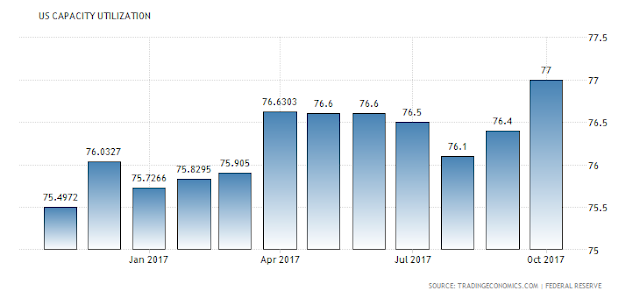Low capacity utilization and weak labor are with us in full force. Capacity utilization still runs below the fifty year average of 80.31 percent in the United States:

As an economic indicator:
Running above an 80-85 percent capacity utilization rate can signal high demand for the products being produced and that capacity is about to be maxed out. When capacity utilization rates get close to 100 percent product, consistency can suffer and the business can lose some control over production or customer service.
However we very well may be at a point where our low capacity utilization is simply not low enough:
Low capacity utilization will more often than not lead to lower prices, which in turn will stimulate demand and increase the capacity utilization. Many businesses increase prices in an attempt to increase profit margins; however, this kind of move only acts to lower the demand for the products and can then lower capacity utilization even more.
Dr. Edward Lambert, who follows capacity utilization closely in formulating his theory of effective demand says this about inflation:
As far as inflation, capacity utilization is low partly because of high profit rates. Low capacity utilization keeps inflation down.
Dr. Lambert makes the point that firms have high debt, but are locking into low rates, also increasing profit margins. While the Fed wants to raise rates, and it is, as he says a tricky thing to do, Dr Lambert believes there is room for the Fed to raise rates some.
But he makes two other significant points regarding excess reserves and inflation. He views the United States as being in some ways similar to Europe and Japan:
Excess reserves have come down a bit as the Fed rate rises. So the future of excess reserves is linked to the future of the Fed rate. So if we get a recession in 6 months, the Fed rate goes back down to zero, and excess reserves are here to stay.
And inflation is not dependent on interest rates at the moment. It is much more a dynamic of high profit rates, low capacity utilization, increased inequality, weak labor power and weak effective demand from lower labor share.
This scenario applies to other countries like Japan and Europe.














Leave A Comment